|
In the course of our lives most of us will encounter individuals, organizations or companies that have achieved more in, or contributed more to a certain field than we would have immediately thought. That you are looking for a lightweight, fixed seat, high performance open water rowing cruiser* at all can be traced to the efforts of Middle Path Boats and its owner/designer Andre de Bardelaben. The folks at Middle Path Boats didn’t invent the type - our great-grandparents knew it well - but they did reintroduce the concept to modern audiences and updated it by incorporating modern building technologies and applying the considerable knowledge gained about small craft design over the last hundred years. At a time when most authors and most boat companies were seemingly preparing and outfitting rowers to become either bully docents at maritime labor museums or to qualify to compete in the Olympic Games, Middle Path Boats was turning out rowboats that fit the way most of us live our lives. Consequently Middle Path Boats is connected with more historical “firsts”, “mosts”, “onlys” and design awards than any other company currently producing craft of that type
*A rowing cruiser is a rowing craft designed and proportioned specifically for recreational pursuits, like exercise, sightseeing, picnicking, sport angling and camping. In the Victorian Era they were often referred to as 'pleasure rowboats'.
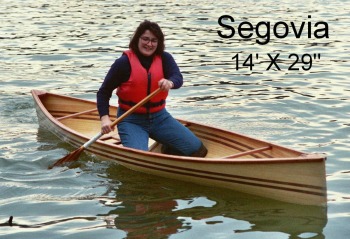 In the late 1970s, after designing a series of sophisticated solo recreational canoes, Mr. de Bardelaben designed his first rowing cruiser, the 16’ x 33”, 70 lbs. Sockeye. Andre’s career path could be said to have followed in the proud tradition of many of the most notable rowing craft designers of the late 19th century, when rowing was America’s most popular outdoor activity. Designers like J. Henry Rushton and Fletcher Joyner were also master canoe designers. Shaping narrow, low-sided, undecked canoes that are stable, seaworthy and efficient is no mean feat. It requires a thorough understanding of hull design and minute attention to detail. Those kinds of skills and that kind of effort when applied to the design of rowboats, which are typically deeper, wider and overall more forgiving than canoes, can yield tremendous performance dividends.
In the late 1970s, after designing a series of sophisticated solo recreational canoes, Mr. de Bardelaben designed his first rowing cruiser, the 16’ x 33”, 70 lbs. Sockeye. Andre’s career path could be said to have followed in the proud tradition of many of the most notable rowing craft designers of the late 19th century, when rowing was America’s most popular outdoor activity. Designers like J. Henry Rushton and Fletcher Joyner were also master canoe designers. Shaping narrow, low-sided, undecked canoes that are stable, seaworthy and efficient is no mean feat. It requires a thorough understanding of hull design and minute attention to detail. Those kinds of skills and that kind of effort when applied to the design of rowboats, which are typically deeper, wider and overall more forgiving than canoes, can yield tremendous performance dividends.
The Sockeye was followed by more than a dozen other rowing designs (please see photos of examples of our varied models), ranging in length from 14 to 18 feet, with molded beams from 30” to 46”. Some of those designs were pure sliding seat craft, others were fixed seat only and some were outfitted for both. We believe that Andre has more experience rowing from both a fixed and a sliding seat, in the same hulls, than any other living person. His observations led him to conclude that boats of moderate length can derive no meaningful performance boost from installing a sliding seat apparatus. Furthermore, he believes that complex sliding seat rigging actually renders these craft less efficient than the same designs with simpler, stationary thwarts. That his fixed seat rowboats often beat most or all of the recreational shells in multi-class, open water races only bolstered his beliefs. As a result, for more than two decades Andre has been America’s most outspoken proponent of high performance, fixed seat rowing craft(1). Not since the death of L. Francis Herreshoff has an individual spoken with such clarity on the virtues of sensible recreational rowboat designs.
Getting the message out has not been easy. Through the 1970s, 80s and early 90s most people thought that any sliding seat shell, no matter how short, was fast. They also believed that any fixed seat rowing craft needed to be deep, beamy and heavy in order to operate safely in rough water. Things began to change in 1990 when a group of open water rowing enthusiasts on Cape Cod, called the Vikings, decided to find out, conclusively, which designs performed best in the coastal environment. They did this throughout the 1990s by hosting an annual event called the Oarmaster Trials. The ‘Trials’ were held at various ocean-front sites around the Cape selected to test the speed and handling of all the invited craft in real-world conditions. The volume of data they gathered on a wide range of boat types is staggering. The Vikings’* near decade long experiment was the most complete and most important of its type. Sadly, it remains underreported and largely unknown within the general rowing community. Were Trials findings better publicized there would be much less confusion about rowboats and rowing, and more designers and builders might be encouraged to be accurate when making claims.
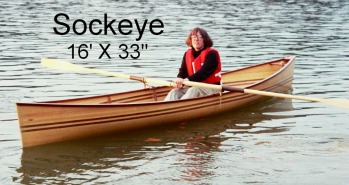 The Vikings devised a clever formula for comparing rowboat designs that tapped into the competitive spirit present in nearly all individuals. It’s been said that anytime two boaters in similar craft are going in the same direction at least one of the skippers is racing. While few fixed seat rowers are serious racers, none of us likes to lose. In the true spirit of consumer product testing the organizers of the Oarmaster Trials made a conscious effort to separate the effects of design from human factors, like advanced skills, competitive experience and strength. To do otherwise might have skewed the results in favor of specialized designs that are best left in the hands of experts. (Incidentally, all of the boats that were tested in this study could carry camping gear sufficient for several days and/or safely accommodate a passenger or two in moderate conditions). They did this by having all of the rowers in each of the events race in all of the participating boats. Simply put, if there were 10 rowers and 10 boats taking part in an event a series of ten races would be run with each rower in a different boat for each race. Thus the handling flaws of each design would be exposed by the weakest rowers. At the conclusion of each event the boat with the lowest accumulated time would be declared the overall winner of the Trials and the rower with the lowest accumulated time would be declared the “Oarmaster”, hence the name of the event
The Vikings devised a clever formula for comparing rowboat designs that tapped into the competitive spirit present in nearly all individuals. It’s been said that anytime two boaters in similar craft are going in the same direction at least one of the skippers is racing. While few fixed seat rowers are serious racers, none of us likes to lose. In the true spirit of consumer product testing the organizers of the Oarmaster Trials made a conscious effort to separate the effects of design from human factors, like advanced skills, competitive experience and strength. To do otherwise might have skewed the results in favor of specialized designs that are best left in the hands of experts. (Incidentally, all of the boats that were tested in this study could carry camping gear sufficient for several days and/or safely accommodate a passenger or two in moderate conditions). They did this by having all of the rowers in each of the events race in all of the participating boats. Simply put, if there were 10 rowers and 10 boats taking part in an event a series of ten races would be run with each rower in a different boat for each race. Thus the handling flaws of each design would be exposed by the weakest rowers. At the conclusion of each event the boat with the lowest accumulated time would be declared the overall winner of the Trials and the rower with the lowest accumulated time would be declared the “Oarmaster”, hence the name of the event
As might have been expected, the first couple of Trials were dominated by dories, Whitehalls, peapods and other husky, coastal workboat inspired types, measuring between 10.5’ and 17’long, weighing 150 to 400 lbs. The really heavy craft, 250 to 400 pounds, including a very shapely Whitehall, were the worst losers. The 1990 and 1991 Oarmaster Trials were won by a 150 lbs, 15’, "knuckle-sided” Gunning dory, with a 12.5’ waterline and about a 4' beam.
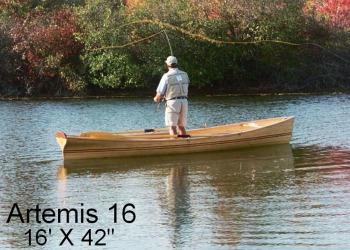 In 1992 everything changed when Middle Path Boats was invited to bring one of their “radical”, lightweight rowing cruisers to take part in the experiment. Twenty rowboats turned out that year, including several built to designs from the boards of very famous designer/authors. We chose to bring a low-sided, round-bottomed, keel-less and skeg-less, 85 lbs., 16’strip-built rowing craft with a molded beam of only 38 inches and nearly plumb stems. Our low profiled Skua not only ran completely dry, but remained controllable in the 20 knot winds that blew from the first race to the last. Skua’s combination of low “sail area” and long, fine underwater lines proved to be a winning formula, easily handled by even the weakest rowers. The final result that day was not close, there was Skua, way out front, and then there were the other boats. After Middle Path Boats’ Skua won in 1992 and our similar Sockeye (Sockeye was declared the overall winner) dominated the 1993 Oarmaster Trials from beginning to end, the "Middle Path form", low, narrow and light with a long waterline, became the archetype for all future high performance open water rowing craft. All subsequent Trials winners could be described as being long, low and light. So ultimately, what were the overall findings of the Oarmaster Trials? In a nutshell this is what was learned. Without exception, lighter rowboats performed better than very heavy ones. Boats over 200 lbs. always finished near the bottom. Overall, boats with rounded hull sections tended to outperform those with sharply angular sections . When comparing boats of similar length, those with softer, more sophisticated sectional shapes generally performed better than those with harder shapes. We also learned that open water rowboats can be too deep, often dangerously so. The effects of excessive depth were particularly apparent in the longer boats in strong winds. Fixed seat rowboats of normal design (undecked, oarlocks on gunwales) can be too long. Those longer than 17’ often had problems dealing with wind, and those over 18’ never did well. This was probably due to the combined influences of increased weight, windage and wetted surface. From 1992 until the end of the Trials all of the winning boats weighed under 135 lbs. and had waterline lengths between 15.5 and 16.25 feet. The final important thing learned from the Trials is that the ability to design and build quality rowboats hasn’t diminished since the 19th century. Starting with Skua in 1992, four of the seven events rowed by solo oarsman (1995 and’96 were rowed double) were won by boats whose designers are still alive. Over the entire run of the Oarmaster Trials, Andre de Bardelaben is the only designer to have had more than one design declared event winners(2). At 85 lbs. and 70 lbs., respectively, the Middle Path Boats Skua and Sockeye became the lightest craft ever to have won an Oarmaster Trials. In doing so they set the standard for the kind of performance and convenience that recreational rowers would demand going forward.
In 1992 everything changed when Middle Path Boats was invited to bring one of their “radical”, lightweight rowing cruisers to take part in the experiment. Twenty rowboats turned out that year, including several built to designs from the boards of very famous designer/authors. We chose to bring a low-sided, round-bottomed, keel-less and skeg-less, 85 lbs., 16’strip-built rowing craft with a molded beam of only 38 inches and nearly plumb stems. Our low profiled Skua not only ran completely dry, but remained controllable in the 20 knot winds that blew from the first race to the last. Skua’s combination of low “sail area” and long, fine underwater lines proved to be a winning formula, easily handled by even the weakest rowers. The final result that day was not close, there was Skua, way out front, and then there were the other boats. After Middle Path Boats’ Skua won in 1992 and our similar Sockeye (Sockeye was declared the overall winner) dominated the 1993 Oarmaster Trials from beginning to end, the "Middle Path form", low, narrow and light with a long waterline, became the archetype for all future high performance open water rowing craft. All subsequent Trials winners could be described as being long, low and light. So ultimately, what were the overall findings of the Oarmaster Trials? In a nutshell this is what was learned. Without exception, lighter rowboats performed better than very heavy ones. Boats over 200 lbs. always finished near the bottom. Overall, boats with rounded hull sections tended to outperform those with sharply angular sections . When comparing boats of similar length, those with softer, more sophisticated sectional shapes generally performed better than those with harder shapes. We also learned that open water rowboats can be too deep, often dangerously so. The effects of excessive depth were particularly apparent in the longer boats in strong winds. Fixed seat rowboats of normal design (undecked, oarlocks on gunwales) can be too long. Those longer than 17’ often had problems dealing with wind, and those over 18’ never did well. This was probably due to the combined influences of increased weight, windage and wetted surface. From 1992 until the end of the Trials all of the winning boats weighed under 135 lbs. and had waterline lengths between 15.5 and 16.25 feet. The final important thing learned from the Trials is that the ability to design and build quality rowboats hasn’t diminished since the 19th century. Starting with Skua in 1992, four of the seven events rowed by solo oarsman (1995 and’96 were rowed double) were won by boats whose designers are still alive. Over the entire run of the Oarmaster Trials, Andre de Bardelaben is the only designer to have had more than one design declared event winners(2). At 85 lbs. and 70 lbs., respectively, the Middle Path Boats Skua and Sockeye became the lightest craft ever to have won an Oarmaster Trials. In doing so they set the standard for the kind of performance and convenience that recreational rowers would demand going forward.
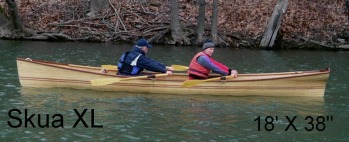 Encouraged by the success of Skua in the 1992 Oarmaster Trails, in 1993 we put our Skua prototype into the able hands of oarsman Cliff Punchard of Wells, Maine, who absolutely dominated the men’s single class on the Fixed Seat Open Water (FSOW) rowing circuit. In 8 races Cliff won 6, with no finishes worst than third place. One of Cliff’s wins was in the Blackburn Challenge, an 18 nautical mile race around Cape Ann, which he won by 22 minutes in very rough conditions. It was during the 1993 season that Skua earned the distinction of being the first sub-100 lbs. fixed seat craft to enter, and win, a major, regularly scheduled, open water race, in modern times(3).
Encouraged by the success of Skua in the 1992 Oarmaster Trails, in 1993 we put our Skua prototype into the able hands of oarsman Cliff Punchard of Wells, Maine, who absolutely dominated the men’s single class on the Fixed Seat Open Water (FSOW) rowing circuit. In 8 races Cliff won 6, with no finishes worst than third place. One of Cliff’s wins was in the Blackburn Challenge, an 18 nautical mile race around Cape Ann, which he won by 22 minutes in very rough conditions. It was during the 1993 season that Skua earned the distinction of being the first sub-100 lbs. fixed seat craft to enter, and win, a major, regularly scheduled, open water race, in modern times(3).
In 1994 Cliff Punchard loaned his Skua to Ben Booth of Mashpee, MA, and Ben took up where Cliff left off by handily winning nearly every race he entered, including the Blackburn Challenge. Ben was so happy with the performance of Cliff’s Skua that he purchased his own Skua for the 1995 FSOW season. In 1995 Ben shattered the existing men’s, fixed seat, single class record in the Blackburn Challenge by more than 19 minutes! Though he never defended it, Ben’s record, set in Skua, stood for many years. At one time or another, Skua has won nearly every major, regularly scheduled race on the East Coast. For more than twenty years Andre de Bardelaben was the only living designer of a men’s, fixed seat, single class Blackburn Challenge winner.
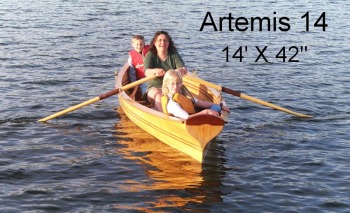 We can only wonder what sort of performances we might have seen from Skua had she to deal with more worthy opposition. Since shortly after Skua appeared on the open water scene the folly of pressing any obsolete coastal workboat design into the role of a general recreational rowing craft should have been obvious to everyone. Almost unrecognized in Skua’s dominance of the fixed seat, open water class was the fact that, in mixed class races, Skua was outperforming most of the entry level sliding seat shells too(4). Those in the rowing industry noticed, and within a few years other companies entered the market with their interpretations of the Skua concept. Some of those introductions were built to new designs while others were more than a century old. None has quite equaled Skua’s blend of civility, versatility, seaworthiness and performance. As a platform for activities as diverse as hunting, fishing, camping, photography and competition none of the new designs can compare. The greatest effect of Skua’s success is the influence it has had on the buying habits of recreational rowers. Following the absolute dominance of this pure cruising craft in open water competition in the early to mid-1990s the average beam of new, fixed seat rowboats has decreased by nearly one foot and average weights have dropped by nearly 100 lbs. In so many ways those new craft are much easier to handle both in and out of the water. As a result modern rowers are enjoying a level of performance and convenience that has not been known in over a century.
We can only wonder what sort of performances we might have seen from Skua had she to deal with more worthy opposition. Since shortly after Skua appeared on the open water scene the folly of pressing any obsolete coastal workboat design into the role of a general recreational rowing craft should have been obvious to everyone. Almost unrecognized in Skua’s dominance of the fixed seat, open water class was the fact that, in mixed class races, Skua was outperforming most of the entry level sliding seat shells too(4). Those in the rowing industry noticed, and within a few years other companies entered the market with their interpretations of the Skua concept. Some of those introductions were built to new designs while others were more than a century old. None has quite equaled Skua’s blend of civility, versatility, seaworthiness and performance. As a platform for activities as diverse as hunting, fishing, camping, photography and competition none of the new designs can compare. The greatest effect of Skua’s success is the influence it has had on the buying habits of recreational rowers. Following the absolute dominance of this pure cruising craft in open water competition in the early to mid-1990s the average beam of new, fixed seat rowboats has decreased by nearly one foot and average weights have dropped by nearly 100 lbs. In so many ways those new craft are much easier to handle both in and out of the water. As a result modern rowers are enjoying a level of performance and convenience that has not been known in over a century.
In the mid-1990s the decision was made to make our most popular designs available to more rowers by offering them in an affordable fiberglass layup, starting with Skua. In less than two years the fiberglass version of this versatile, history making design outsold all of our models in wood/epoxy/fiberglass composite, combined. By 2007, in order to keep up with demand, we dropped the wood based boats entirely.
Middle Path Boats remains the leader in the field of modern, scientific, fixed seat rowboat design. In 2003, at the Mid-Atlantic Small Craft Festival at the Chesapeake Bay Maritime Museum (www.cbmm.org) in St. Michaels, MD, in addition to winning both the men’s and women’s rowing races, Skua received a design award for its new one-piece liner that rendered this craft unsinkable and as self-righting as a rowboat this size and type can be.
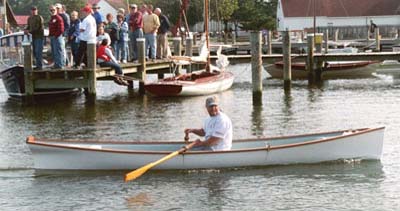 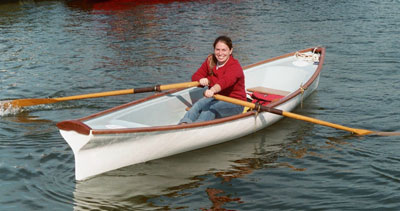
Congratulations to Brian Shexnayder and Lacey England on their fine victories at MASCF XXI in 2003.
If you’re reading all of this for the first time, you’re probably wondering why you’ve never heard of most of these historically significant events. Though we achieved nearly every meaningful goal that a design-oriented rowing craft company can many years ago, our most difficult, time consuming, and very lonely, task since then has been to convey to the general rowing community what characteristics a proper recreational rowing craft should have. Most often that message has been delivered to individuals or very small groups as currently there are no periodicals devoted to covering the sport of fixed seat rowing. And though most of the hard data on fixed seat rowing craft design has been gathered since 1990, and all of the important events have been witnessed by well-known, published authors, nobody has produced a major new book on fixed seat rowing since the 1980s. Should activities like hand-lining for cod, gillnetting for salmon or riverine log driving from rowboats make an unexpected return, there’s a shelf of texts that will explain what equipment you’ll need, but there hasn’t been a comprehensive book published on recreational fixed seat rowing in more than a century. The gap between what we know about fixed seat pleasure rowboats and what you can read about them has never been greater than it is right now. While we can only speculate as to why some parties might prefer that you not know about some of the above reported events, we at Middle Path Boats feel that a fully informed consumer will likely be a satisfied consumer..
**Nobody from Middle Path Boats is a member of the Cape Cod Vikings. No one at Middle Path Boats was involved in choosing the event sites or participants, nor were they involved in organizing or running the Oarmaster Trials. None of the rowers or boat suppliers paid or was paid to take part. The prize awarded at the end of each event was a small handmade plaque that had no cash value.
REFERENCES
1“Back to the Future What Does Rowing Offer Today?” Messing About In BOATS,
Vol. 11, No. 3, June 15, 1993, pp. 10 – 13.
2“The 1993 Oarmaster Trials,” Messing About In BOATS, Vol. 11, No. 14, Dec. 1,
1993, pp. 11 – 15.
3“Blackburn Challenge 1993,” Messing About In BOATS, Vol. 11, No. 9, Sept. 15,
1993, pp. 6 – 7.
4“Fixed- versus Sliding- Seat Efficiency,” Open-Water Rowing, Issue 10, Nov.
1998, pp. 4, 16.
|







 In the late 1970s, after designing a series of sophisticated solo recreational canoes, Mr. de Bardelaben designed his first rowing cruiser, the 16’ x 33”, 70 lbs. Sockeye. Andre’s career path could be said to have followed in the proud tradition of many of the most notable rowing craft designers of the late 19th century, when rowing was America’s most popular outdoor activity. Designers like J. Henry Rushton and Fletcher Joyner were also master canoe designers. Shaping narrow, low-sided, undecked canoes that are stable, seaworthy and efficient is no mean feat. It requires a thorough understanding of hull design and minute attention to detail. Those kinds of skills and that kind of effort when applied to the design of rowboats, which are typically deeper, wider and overall more forgiving than canoes, can yield tremendous performance dividends.
In the late 1970s, after designing a series of sophisticated solo recreational canoes, Mr. de Bardelaben designed his first rowing cruiser, the 16’ x 33”, 70 lbs. Sockeye. Andre’s career path could be said to have followed in the proud tradition of many of the most notable rowing craft designers of the late 19th century, when rowing was America’s most popular outdoor activity. Designers like J. Henry Rushton and Fletcher Joyner were also master canoe designers. Shaping narrow, low-sided, undecked canoes that are stable, seaworthy and efficient is no mean feat. It requires a thorough understanding of hull design and minute attention to detail. Those kinds of skills and that kind of effort when applied to the design of rowboats, which are typically deeper, wider and overall more forgiving than canoes, can yield tremendous performance dividends.  The Vikings devised a clever formula for comparing rowboat designs that tapped into the competitive spirit present in nearly all individuals. It’s been said that anytime two boaters in similar craft are going in the same direction at least one of the skippers is racing. While few fixed seat rowers are serious racers, none of us likes to lose. In the true spirit of consumer product testing the organizers of the Oarmaster Trials made a conscious effort to separate the effects of design from human factors, like advanced skills, competitive experience and strength. To do otherwise might have skewed the results in favor of specialized designs that are best left in the hands of experts. (Incidentally, all of the boats that were tested in this study could carry camping gear sufficient for several days and/or safely accommodate a passenger or two in moderate conditions). They did this by having all of the rowers in each of the events race in all of the participating boats. Simply put, if there were 10 rowers and 10 boats taking part in an event a series of ten races would be run with each rower in a different boat for each race. Thus the handling flaws of each design would be exposed by the weakest rowers. At the conclusion of each event the boat with the lowest accumulated time would be declared the overall winner of the Trials and the rower with the lowest accumulated time would be declared the “Oarmaster”, hence the name of the event
The Vikings devised a clever formula for comparing rowboat designs that tapped into the competitive spirit present in nearly all individuals. It’s been said that anytime two boaters in similar craft are going in the same direction at least one of the skippers is racing. While few fixed seat rowers are serious racers, none of us likes to lose. In the true spirit of consumer product testing the organizers of the Oarmaster Trials made a conscious effort to separate the effects of design from human factors, like advanced skills, competitive experience and strength. To do otherwise might have skewed the results in favor of specialized designs that are best left in the hands of experts. (Incidentally, all of the boats that were tested in this study could carry camping gear sufficient for several days and/or safely accommodate a passenger or two in moderate conditions). They did this by having all of the rowers in each of the events race in all of the participating boats. Simply put, if there were 10 rowers and 10 boats taking part in an event a series of ten races would be run with each rower in a different boat for each race. Thus the handling flaws of each design would be exposed by the weakest rowers. At the conclusion of each event the boat with the lowest accumulated time would be declared the overall winner of the Trials and the rower with the lowest accumulated time would be declared the “Oarmaster”, hence the name of the event  In 1992 everything changed when Middle Path Boats was invited to bring one of their “radical”, lightweight rowing cruisers to take part in the experiment. Twenty rowboats turned out that year, including several built to designs from the boards of very famous designer/authors. We chose to bring a low-sided, round-bottomed, keel-less and skeg-less, 85 lbs., 16’strip-built rowing craft with a molded beam of only 38 inches and nearly plumb stems. Our low profiled Skua not only ran completely dry, but remained controllable in the 20 knot winds that blew from the first race to the last. Skua’s combination of low “sail area” and long, fine underwater lines proved to be a winning formula, easily handled by even the weakest rowers. The final result that day was not close, there was Skua, way out front, and then there were the other boats. After Middle Path Boats’ Skua won in 1992 and our similar Sockeye (Sockeye was declared the overall winner) dominated the 1993 Oarmaster Trials from beginning to end, the "Middle Path form", low, narrow and light with a long waterline, became the archetype for all future high performance open water rowing craft. All subsequent Trials winners could be described as being long, low and light. So ultimately, what were the overall findings of the Oarmaster Trials? In a nutshell this is what was learned. Without exception, lighter rowboats performed better than very heavy ones. Boats over 200 lbs. always finished near the bottom. Overall, boats with rounded hull sections tended to outperform those with sharply angular sections . When comparing boats of similar length, those with softer, more sophisticated sectional shapes generally performed better than those with harder shapes. We also learned that open water rowboats can be too deep, often dangerously so. The effects of excessive depth were particularly apparent in the longer boats in strong winds. Fixed seat rowboats of normal design (undecked, oarlocks on gunwales) can be too long. Those longer than 17’ often had problems dealing with wind, and those over 18’ never did well. This was probably due to the combined influences of increased weight, windage and wetted surface. From 1992 until the end of the Trials all of the winning boats weighed under 135 lbs. and had waterline lengths between 15.5 and 16.25 feet. The final important thing learned from the Trials is that the ability to design and build quality rowboats hasn’t diminished since the 19th century. Starting with Skua in 1992, four of the seven events rowed by solo oarsman (1995 and’96 were rowed double) were won by boats whose designers are still alive. Over the entire run of the Oarmaster Trials, Andre de Bardelaben is the only designer to have had more than one design declared event winners(2). At 85 lbs. and 70 lbs., respectively, the Middle Path Boats Skua and Sockeye became the lightest craft ever to have won an Oarmaster Trials. In doing so they set the standard for the kind of performance and convenience that recreational rowers would demand going forward.
In 1992 everything changed when Middle Path Boats was invited to bring one of their “radical”, lightweight rowing cruisers to take part in the experiment. Twenty rowboats turned out that year, including several built to designs from the boards of very famous designer/authors. We chose to bring a low-sided, round-bottomed, keel-less and skeg-less, 85 lbs., 16’strip-built rowing craft with a molded beam of only 38 inches and nearly plumb stems. Our low profiled Skua not only ran completely dry, but remained controllable in the 20 knot winds that blew from the first race to the last. Skua’s combination of low “sail area” and long, fine underwater lines proved to be a winning formula, easily handled by even the weakest rowers. The final result that day was not close, there was Skua, way out front, and then there were the other boats. After Middle Path Boats’ Skua won in 1992 and our similar Sockeye (Sockeye was declared the overall winner) dominated the 1993 Oarmaster Trials from beginning to end, the "Middle Path form", low, narrow and light with a long waterline, became the archetype for all future high performance open water rowing craft. All subsequent Trials winners could be described as being long, low and light. So ultimately, what were the overall findings of the Oarmaster Trials? In a nutshell this is what was learned. Without exception, lighter rowboats performed better than very heavy ones. Boats over 200 lbs. always finished near the bottom. Overall, boats with rounded hull sections tended to outperform those with sharply angular sections . When comparing boats of similar length, those with softer, more sophisticated sectional shapes generally performed better than those with harder shapes. We also learned that open water rowboats can be too deep, often dangerously so. The effects of excessive depth were particularly apparent in the longer boats in strong winds. Fixed seat rowboats of normal design (undecked, oarlocks on gunwales) can be too long. Those longer than 17’ often had problems dealing with wind, and those over 18’ never did well. This was probably due to the combined influences of increased weight, windage and wetted surface. From 1992 until the end of the Trials all of the winning boats weighed under 135 lbs. and had waterline lengths between 15.5 and 16.25 feet. The final important thing learned from the Trials is that the ability to design and build quality rowboats hasn’t diminished since the 19th century. Starting with Skua in 1992, four of the seven events rowed by solo oarsman (1995 and’96 were rowed double) were won by boats whose designers are still alive. Over the entire run of the Oarmaster Trials, Andre de Bardelaben is the only designer to have had more than one design declared event winners(2). At 85 lbs. and 70 lbs., respectively, the Middle Path Boats Skua and Sockeye became the lightest craft ever to have won an Oarmaster Trials. In doing so they set the standard for the kind of performance and convenience that recreational rowers would demand going forward. Encouraged by the success of Skua in the 1992 Oarmaster Trails, in 1993 we put our Skua prototype into the able hands of oarsman Cliff Punchard of Wells, Maine, who absolutely dominated the men’s single class on the Fixed Seat Open Water (FSOW) rowing circuit. In 8 races Cliff won 6, with no finishes worst than third place. One of Cliff’s wins was in the Blackburn Challenge, an 18 nautical mile race around Cape Ann, which he won by 22 minutes in very rough conditions. It was during the 1993 season that Skua earned the distinction of being the first sub-100 lbs. fixed seat craft to enter, and win, a major, regularly scheduled, open water race, in modern times(3).
Encouraged by the success of Skua in the 1992 Oarmaster Trails, in 1993 we put our Skua prototype into the able hands of oarsman Cliff Punchard of Wells, Maine, who absolutely dominated the men’s single class on the Fixed Seat Open Water (FSOW) rowing circuit. In 8 races Cliff won 6, with no finishes worst than third place. One of Cliff’s wins was in the Blackburn Challenge, an 18 nautical mile race around Cape Ann, which he won by 22 minutes in very rough conditions. It was during the 1993 season that Skua earned the distinction of being the first sub-100 lbs. fixed seat craft to enter, and win, a major, regularly scheduled, open water race, in modern times(3).  We can only wonder what sort of performances we might have seen from Skua had she to deal with more worthy opposition. Since shortly after Skua appeared on the open water scene the folly of pressing any obsolete coastal workboat design into the role of a general recreational rowing craft should have been obvious to everyone. Almost unrecognized in Skua’s dominance of the fixed seat, open water class was the fact that, in mixed class races, Skua was outperforming most of the entry level sliding seat shells too(4). Those in the rowing industry noticed, and within a few years other companies entered the market with their interpretations of the Skua concept. Some of those introductions were built to new designs while others were more than a century old. None has quite equaled Skua’s blend of civility, versatility, seaworthiness and performance. As a platform for activities as diverse as hunting, fishing, camping, photography and competition none of the new designs can compare. The greatest effect of Skua’s success is the influence it has had on the buying habits of recreational rowers. Following the absolute dominance of this pure cruising craft in open water competition in the early to mid-1990s the average beam of new, fixed seat rowboats has decreased by nearly one foot and average weights have dropped by nearly 100 lbs. In so many ways those new craft are much easier to handle both in and out of the water. As a result modern rowers are enjoying a level of performance and convenience that has not been known in over a century.
We can only wonder what sort of performances we might have seen from Skua had she to deal with more worthy opposition. Since shortly after Skua appeared on the open water scene the folly of pressing any obsolete coastal workboat design into the role of a general recreational rowing craft should have been obvious to everyone. Almost unrecognized in Skua’s dominance of the fixed seat, open water class was the fact that, in mixed class races, Skua was outperforming most of the entry level sliding seat shells too(4). Those in the rowing industry noticed, and within a few years other companies entered the market with their interpretations of the Skua concept. Some of those introductions were built to new designs while others were more than a century old. None has quite equaled Skua’s blend of civility, versatility, seaworthiness and performance. As a platform for activities as diverse as hunting, fishing, camping, photography and competition none of the new designs can compare. The greatest effect of Skua’s success is the influence it has had on the buying habits of recreational rowers. Following the absolute dominance of this pure cruising craft in open water competition in the early to mid-1990s the average beam of new, fixed seat rowboats has decreased by nearly one foot and average weights have dropped by nearly 100 lbs. In so many ways those new craft are much easier to handle both in and out of the water. As a result modern rowers are enjoying a level of performance and convenience that has not been known in over a century.